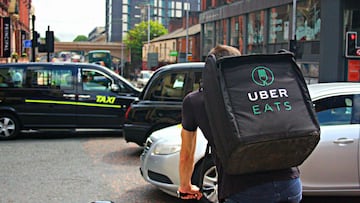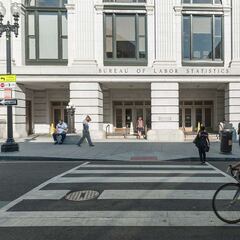New study finds three-quarters of delivery drivers support striking for better wages and conditions
A new study from Circuit shows growing support by delivery drivers for taking strike action to improve working conditions.

A study published by researchers at Circuit, a company focused on last-minute deliveries, found a growing dissatisfaction among delivery workers in the United States.
The workers surveyed hailed from different parts of the country and were employed by various companies. Of the nearly 1,000 workers surveyed, 80 percent said that they felt they were underpaid, with employees from Grubhub (92 percent), DHL (91 percent), and Post Mates (88 percent) reporting these sentiments at the highest levels. Around 15 percent of workers reported that they had already taken on a second job, and 77 percent of those surveyed said they were planning to take another on.
Nearly three-quarters of workers would strike
When asked if they would participate in a strike for better wages and benefits, 73 percent of drivers said yes. The research team found that willingness to strike also increased with age: Baby Boomers (84 percent said yes), Gen X (74 percent), Millennials (68 percent), and Gen Z (68 percent). Older workers could be more frustrated after seeing their labor conditions in terms of pay and benefits deteriorate over the course of their careers, while younger workers may be taking their first steps into jobs where union membership is discouraged or unavailable.
However, the Circuit did not ask if those that would be willing to strike were members of a union. Without a union, workers could stage a wildcat strike, but their employers would not be required to respect the strike or negotiate with the group. For delivery drivers who work through an application like Uber Eats or Grubhub, organizing a strike can be incredibly difficult since there is no centralized way for drivers to communicate. Still, the high figure of workers willing to strike indicates that dissatisfaction among workers is widespread. If the unemployment rate ticks up with rising interest rates, these numbers could fall as job security worries increase.
Wide variation in terms of wages for delivery drivers
The income delivery drivers are able to earn depends on many factors, including the company they work for, the region in which they live, their status as a union member, and the number of hours worked per week.
Delivery drivers employed by UPS, FedEx, and USPS are typically full-time salaried workers, meaning they are likely offered health insurance, paid time off, and retirement benefits. According to Indeed, the hourly rate for delivery drivers at UPS is $24.87, while that of a USPS driver is a little lower, at $19.53. Meanwhile, the starting salary for FedEx as a ‘delivery specialist’ is $25,000, or around $12 an hour (assuming they work 2080 hours a year).
Looking at the entire sector, the Bureau of Labor Statistics reported that in May 2021, the median annual salary for “Light truck drivers,” which covers workers who “drive small trucks or vans from distribution centers to delivery locations” and “make deliveries based on a set schedule,” was $38,280 or $18.40 per hour. The top ten percent of earners made around $65,500, with the bottom ten percent taking home around $24,380.
After reaching out to the companies mentioned in Circuit’s report, only UPS responded and questioned whether the study’s findings were relevant for their company since “it appears that there weren’t any UPS drivers in the survey” (a fact disputed by Circuit). A UPS representative said the company “couldn’t succeed without the dedication, integrity and professionalism of our employees” and noted that they “provide our union-represented employees with industry-leading pay and benefits.”
The state of food delivery drivers
Circuit also surveyed delivery drivers for food delivery apps like Door Dash, Grubhub, and Uber Eats who are not classified as salaried employees but independent contractors. This status as ‘gig’ workers means that drivers are not entitled to benefits like healthcare or sickness and vacation time. When a driver logs into the app, they begin to receive orders, and their pay depends on how many deliveries they are able to complete alongside the tips provided by customers. Since the income generated through food delivery depends on so many factors calculating an average can be difficult.
How much do drivers for food delivery apps make?
The BLS includes food delivery drivers employed through an application, like the aforementioned companies, as “Driver/sales workers.” This category also includes drivers that have “sales responsibilities” or those that “recommend products to businesses and solicit new customers.” An example the BLS gives discusses a driver who may “make regular deliveries to a hardware store and encourage the store’s manager to offer a new product.” Together both groups had a median annual income of $29,280 or $14.07 per hour. When looking at the highest ten percent of earners, the median rose to $47,850, nearly $20,000 lower than those in light trucking; the lowest ten percent earned a median salary of $18,360. All of these salaries are far below the US average wage of nearly $62,000.
Significant organization among workers in the gig economy must be undertaken for gig workers to not only be paid a fair wage but to enjoy the same rights as salaried employees. But with workers unable to see who else they work with, as well as the increased likelihood of workers having multiple jobs, this is a difficult task. Companies like Uber have fought long and costly legal battles to ensure their workers remain independent contractors and not employees. A recent California lawsuit confirmed this working relationship. Many of these companies and the industry lobbyists they hire have worked to block the confirmation of many in the labor movement’s top pick for Labor Secretary, Julie Su. If these app-based firms were forced to employ drivers as salaried workers rather than contractors, they would be forced to offer them health insurance and other critical benefits that would cut significantly into the profit margins of the companies.
In cases of worker deaths, the companies often do not accept responsibility.
“This is a systemic and sickening practice in which these corporations – which do not do enough to protect their workers – try to protect their bottom line by offloading risk on to them,” said Cherri Murphy, a co-author of a study from the organization Gig Workers Rising.
With gig work, US workers are finding that the lack of access to retirement and savings plans poses a challenge to their financial futures.
— Legal & General (@landg_group) April 13, 2023
45% of gig workers don’t expect to retire from their career before the age of 65.
Find out more here: https://t.co/ap5dsdcPii pic.twitter.com/WKQzYzDS2p
Workers at food delivery companies clearly recognize that their labor is instrumental to the business’s bottom line but do not have the means to challenge this effectively. However, even under these difficult conditions, workers in this sector have shown their willingness to organize and stand up to their corporate bosses to demand better conditions and pay.
Delivery drivers and the fight for fair pay
The International Brotherhood of Teamsters union, which represent 70 percent of UPS’s 443,000 employees based in the US, is preparing to begin a major set contract negotiation with company executives this month. On 3 April, the Teamsters put out a press release stating that “UPS Teamsters are demanding the strongest possible contract and are prepared to strike if UPS fails to deliver by the contract’s expiration on 31 July.”
“Full- and part-time UPS Teamsters are united for a contract that guarantees better pay for all workers, more full-time job opportunities, an end to corporate harassment and forced overtime, elimination of a two-tier wage system, and protection from heat and other workplace hazards,” said union leadership when describing their demands.
One of those union leaders is Local 804 president Vinnie Perrone, who told Jacobin writer Alex N. Press that this time members want to be involved in the negotiations. With three decades at UPS under his belt, Perrone said that “he hadn’t seen a membership meeting this well attended since Ron Carey was reelected for a second term as president of the International Brotherhood of Teamsters (IBT).” For those who may be a little young for that reference, Ron Carey won reelection in 1996.
UPS has responded to questions about the possibility of a strike, confident that they will reach a deal by the deadline. CNBC called attention to comments made by CEO Carol Tomé on a call with investors, who reminded those present that these negotiations are not the company’s “first rodeo.” While true, it is the first time in more than 20 years that workers and the public have been so engaged in ongoing labor struggles, which adds an additional layer of pressure for all sides. Polling from Gallup last year suggests trade union support to be at its highest level since 1965.
Teamster General President Sean O’Brien has called attention to the fact that UPS has not finalized the regional agreements, which the union has been clear, must be agreed to before conversations over a national contract can begin. Of these supplemental contacts, the Teamsters say only ten of forty have been finalized. Negotiations over these contracts began in January, which the union believes was “piss-poor planning,” tweeted O’Brien.
.@UPS’s piss-poor planning & unpreparedness does not constitute an emergency on the @Teamsters behalf during negotiations. This company has 12 weeks to either settle the deal or put themselves on strike. We’re not playing games, ball is in your court ⏰⏱️
— Sean O'Brien (@TeamsterSOB) April 12, 2023
Related stories
“We are not going to accept and take what UPS gives us,” O’Brien declared at a rally. “UPS Teamsters have fire in their eyes and the intestinal fortitude to take on this company.”
A victory for the Teamsters in their dispute could set the tone for the vast majority of delivery workers shown by the survey to be at the end of their patience.

